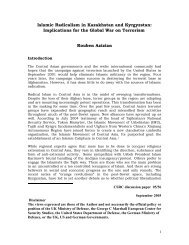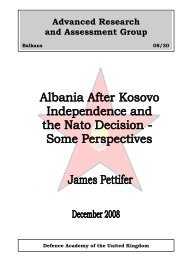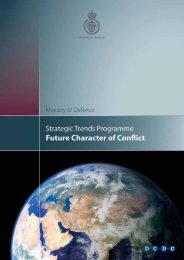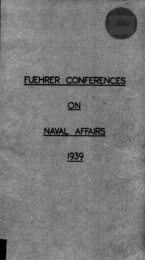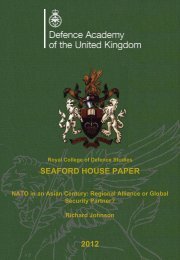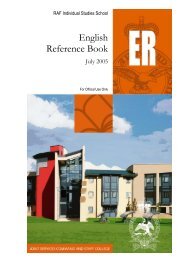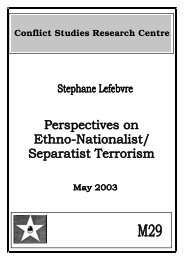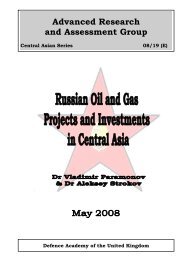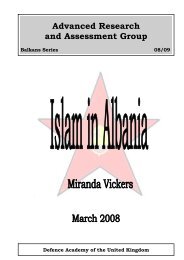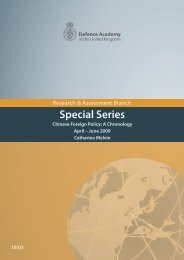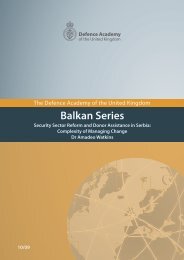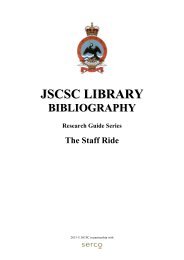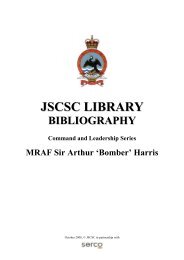Russia's European Agenda and The Baltic States - Defence ...
Russia's European Agenda and The Baltic States - Defence ...
Russia's European Agenda and The Baltic States - Defence ...
You also want an ePaper? Increase the reach of your titles
YUMPU automatically turns print PDFs into web optimized ePapers that Google loves.
RUSSIA’S EUROPEAN AGENDA AND THE BALTIC STATES<br />
<strong>and</strong> the EU in order to develop the possibility for future membership, may considerable<br />
weaken the CIS structures <strong>and</strong> is challenging Russia’s dominant position in the FSU.<br />
Moreover, currently on the rise is the GUAM grouping, which is considered by its<br />
member states to become an alternative to the Russia-centric CIS organisation.<br />
Today’s Russia is not so much neo-imperialist as post-imperialist. When it<br />
comes to the post-Soviet space, Russia is often forced onto the retreat. As a result,<br />
Russia has been on an offensive to challenge Western (particularly US) influence in<br />
the ‘near-abroad’ <strong>and</strong> is unable to keep the whole CIS in her ‘sphere of influence’.<br />
<strong>The</strong> best that Russia could do for her smaller neighbours would be to become more<br />
stable, prosperous <strong>and</strong> at peace with herself. This would give Russia considerable<br />
‘soft’ power – the ability to convince rather than coerce – in the post-Soviet space.<br />
Colour revolutions may not weaken Russia’s position in the CIS provided that<br />
Russia has a pragmatic policy of non-involvement. <strong>The</strong> main lesson from the postrevolutionary<br />
period in Georgia, Ukraine <strong>and</strong> the events in Kyrgyzstan is that Russia<br />
should develop cooperation with other regional players, including Europe, the<br />
United <strong>States</strong> <strong>and</strong> their key institutions, in the interest of stability <strong>and</strong> development<br />
in what has become their ‘common neighbourhood’. EU enlargement <strong>and</strong> the<br />
so-called ‘war on terror’ have provided a lasting strategic rationale for Western<br />
engagement in Eurasia. Russia has yet to formulate clear strategic interests in her<br />
relations with neighbours on the basis of post-Cold War <strong>and</strong> post-9/11 realities that<br />
go beyond historic legacy <strong>and</strong> fears of encirclement.<br />
Russo-<strong>Baltic</strong> Relations<br />
Explaining the Russo-<strong>Baltic</strong> Asymmetric Relationship<br />
Russo-<strong>Baltic</strong> relations are marked by some peculiarities. First is the relative <strong>and</strong><br />
structural power disparity between Russia <strong>and</strong> the <strong>Baltic</strong> countries. Secondly, Russia<br />
has never come to terms with the <strong>Baltic</strong> independence. Third, relations are based on<br />
geographical proximity, the geo-strategic position of the <strong>Baltic</strong> <strong>States</strong> <strong>and</strong> the historical<br />
past. It is the latter that gives plenty of reasons for the <strong>Baltic</strong>s to fear their big neighbour:<br />
a traditional imperial policy is ingrained in Russia’s bearing historically <strong>and</strong> culturally.<br />
Such a Russian approach presupposes the necessity to maintain some spheres of<br />
influence – a means of accumulation of Russian power, which opens the door for<br />
Russia’s penetration into economic <strong>and</strong> political processes of the neighbouring states.<br />
It is for this reason that the <strong>Baltic</strong> countries perceive an increasing Russian power as a<br />
negative factor for their mutual relations. <strong>The</strong> Russia-related threats to the <strong>Baltic</strong> <strong>States</strong><br />
manifest in several different forms of pressure: economical, political <strong>and</strong> cultural.<br />
<strong>The</strong> Knudsen model helps analyse many features of asymmetric relationship<br />
between a great power <strong>and</strong> a small state. All six independent variables of this model<br />
(the importance of a small state’s geographic location; tension variable – degree of<br />
tension between great powers; power cycle variable – the degree of extroversion<br />
in a great power’s foreign policy; historical past (historical record); policy of other<br />
rival great power(s) towards a small state; environment of multilateral security <strong>and</strong><br />
32



